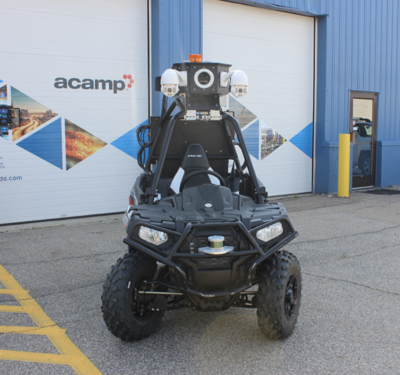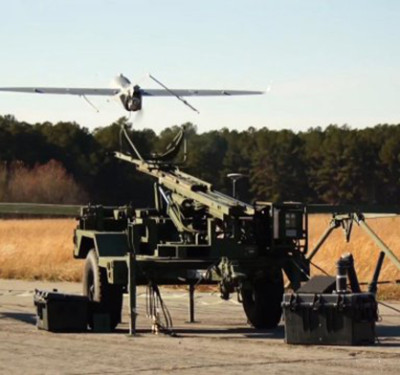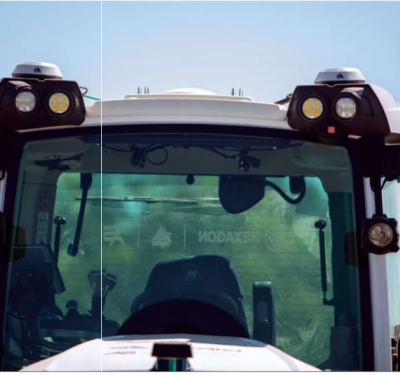The four-month-long Battle of Avdiivka (October 2023-February 2024) is one of the bloodiest battles of the 21st century to date. It also arguably stands as the first occasion that unmanned ground vehicles (UGVs) took on a prominent operational role.
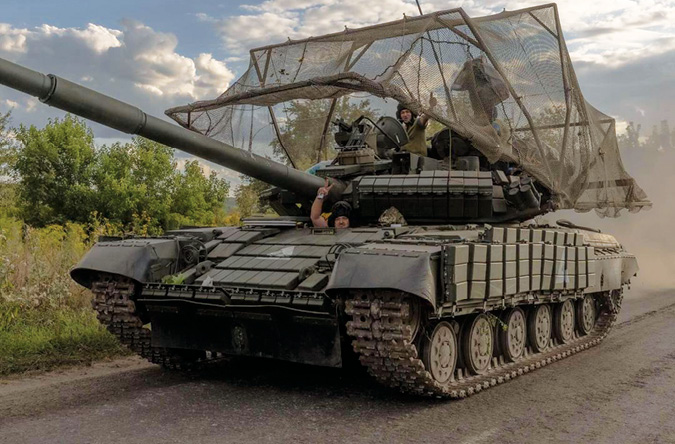
This ruined and heavily fortified city in the Donetsk Oblast region of Ukraine, Avdiivka, became the primary focus of Russian offensive operations following the petering-out of Ukraine’s 2023 counteroffensive. The campaign coincided with the ascension of U.S. House Speaker Mike Johnson who placed a block on U.S. military aid that soon caused a disastrous shortage of artillery shells for Ukraine.
Starved of artillery shells, Ukrainian forces turned to FPV kamikaze drones to become their primary indirect fire and anti-tank weapon.
As Russia’s mechanized assaults repeatedly suffered catastrophic losses to mines and FPV drones, they reverted to blanketing Ukrainian defensive positions with smaller-scale infantry attack instead. These “meat assaults”—sometimes mounted in golf carts or motorcycles in hope of outrunning drone counterstrikes—incurred tens of thousands of casualties. Ukrainian snipers in ruined urban buildings were recorded using Black Hornet nano drones to scan for their Russian counterparts while preparing deadly ambushes.
But Russian artillery superiority, a 9:1 ratio of shells fired, combined with extensive use of UMPK glide bombs blew holes in the over-stretched Ukrainian frontline, allowing Russian forces to gradually locate the gaps and creep forward.
Drones on both sides created a deadly killing zone between frontline positions and their logistical support bases, resulting in heavy losses to supply vehicles negotiating muddy rained-over or snowed-under roads.
In response, both Russia and Ukraine began extensive deployment of UGVs to sustain their supply lines for the first time. And as expected, recordings of FPV kamikaze units striking those UGVs soon began to circulate, too—the war of robot against robot, realized at last. Ukrainian UGVs were also recorded minelaying and were even used to recover a valuable crashed Orlan-30 drone and its laser designator.
The fortunes of the FPV war itself fluctuated: by late fall Russia clearly came to eclipse Ukraine in mass-production of FPVs. But then Ukraine itself developed new techniques, giving it a lasting qualitative edge circumventing Russian electronic warfare.
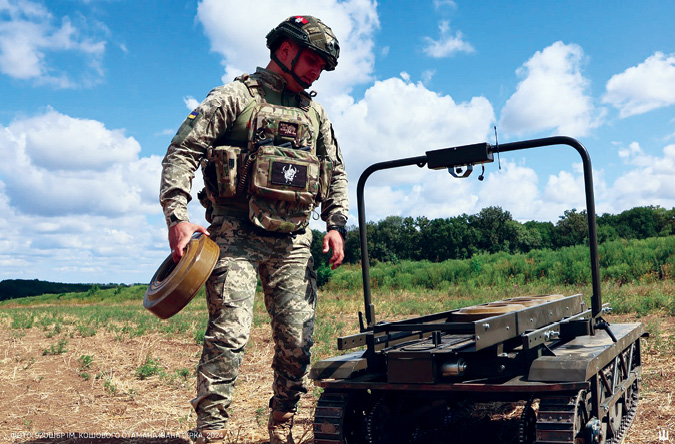
RUSSIA’S MEDIUM-RANGE ISR THREAT AND DRONE-BALLISTIC MISSILE TEAMING
Johnson’s six-month clampdown on Ukraine aid also interrupted the flow of American-supplied air defense missiles to Ukraine, accelerating an already looming crisis as Ukraine depleted non-replaceable stocks of Soviet surface-to-air missiles.
The resulting shortage meant Ukrainian air defenses could no longer afford to expend pricey missiles against cheap Orlan-10 and Orlan-30 drones. Accorded a freer hand, the Russians increasingly penetrated Ukrainian-held airspace and acquired high-value time-sensitive targets at operational depth for destruction by Iskander-M ballistic missiles, including launchers for Patriot, ISIS-T air defense launchers, M142 HIMARS rocket artillery, and landed MiG-29 and Su-25 jets at near-frontline airbases.
Ballistic missiles, while pricey, are attractive due to low time-to-target and large area of effect. Executing such attacks required Russia to develop a horizontal drone-to-missile kill-chain to reduce time delays between target acquisition and fires generation to single-digit minutes.
As the U.S. Army introduces new ballistic missiles into service, such as the Precision Strike Missile, SM-6 and Dark Eagle hypersonic glide vehicle, it too must develop a practiced drone-to-missile launcher kill chain, perhaps in its specialized multi-domain brigades.
Broadly, medium-range ISR drones continue to play a huge role, multiplying the effectiveness of Russia’s indirect-fires oriented ground army. Russian officials claimed to have procured 3,500 UAVs in 2023, referring to ISR drones and not loitering munitions and sUAS.
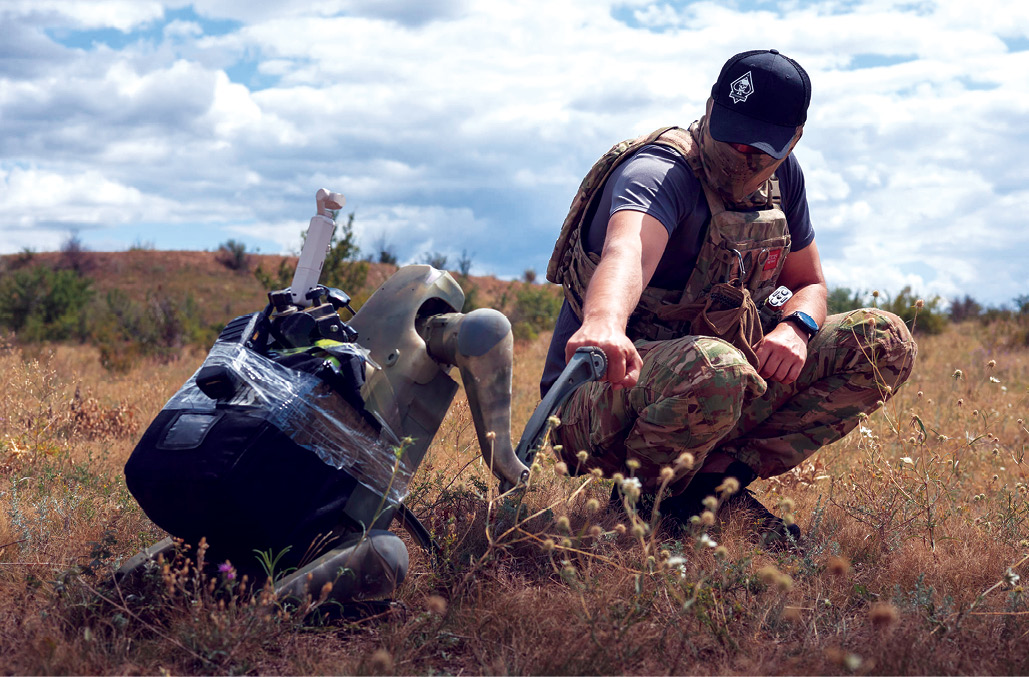
CHARGE OF THE LIGHT (DRONE) BRIGADE
Russia ultimately seized Avdiivka in February at the cost of an estimated 34,000 to 47,000 casualties, including 17,000 killed in action or suffering crippling injuries per Russian sources, and 1,000 armored vehicles. Ukraine claims it lost 5,000 to 7,000 soldiers, perhaps including about 1,000 captured attempting to withdraw. In March, Speaker Johnson finally lifted his block on aid to Ukraine.
At the end of that month, the war brought a new spectacle when a company of six Russian Courier UGVs armed with automatic grenade launcher turrets assembled near Ukraine’s fallback defenses west of Avdiivka to launch a massed attack.
Though alleged to have fired hundreds of grenades, the UGVs were swiftly wiped out, including two gruesomely dismantled on camera by FPV drones. The only consolation: ordinarily, kamikaze drones countering assaults slaughter squads of infantry or platoons of tanks and BMP fighting vehicles. This time, the cost of failure was merely $66,000 worth of drones. Theoretically, Russia’s military could turn to cheap UGVs as substitutes to curb how rapidly it loses soldiers in “meat assaults” when probing Ukrainian defense.
Ukraine, on the defensive side, faces a similar problem. Drones and artillery may do most of the killing, but vulnerable, flesh-and-blood human beings remain indispensable for effectively holding defensive positions. Can that be changed? Ukraine’s military suffers from a more immediate manpower crisis than Russia’s—it may suffer lighter losses compared to Russia, but it has just over one-quarter the population.
Using unmanned sentry systems could theoretically allow the same stretch of frontline to be manned by fewer troops continuously exposed to glide bombing jet, shelling, droning, snipers and tank fire-raids. There is not yet much of a sense that combat UGVs bring capabilities as disruptive as those of UAVs. The primary goal is to reduce losses of soldiers.
In fact, mechanized maneuver warfare exacerbates the Achilles heel of UGVs—their limited viable command-link range compared to aerial drones, combined with the challenges autonomy algorithms face negotiating more complex terrain and combat situations. Thus, it’s precisely the World War I-like conditions now prevalent in Ukraine since 2023 that have enabled the use of cheaper UGVs over shorter distances down relatively predictable corridors.
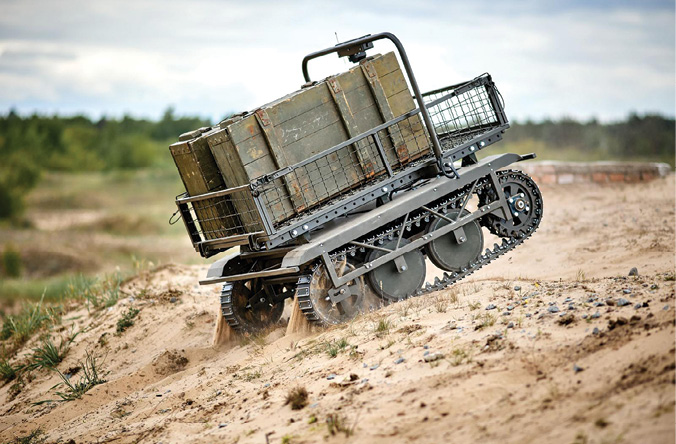
ARMY OF ROBOTS: UKRAINE’S AMBITIOUS UGV PLANS
In March, Ukraine’s United24 fundraising organ unveiled its expansive plans to procure hundreds of unmanned systems for operational use in combat, logistics, minelaying and mine clearance roles. Tech incubator Brave1 had considered 140 UGV and remote weapon system concepts, tested 50 of them, and selected 14 for procurement. An estimated 250 local businesses are now making it happen, with one example UGV described as costing $35,000 each.
The ground combat systems include the Shablya M2 autonomous turret, and Lyut, Moroz and D-21-11 UGVs. All are small, simple four-wheelers described as capable of both assault and defensive missions, as well as surveillance and reconnaissance armed with 7.62-millimeter PKT/PKM machine guns, or 12.7-millimeter NSVT or M2 Brownings. Some are armored against small arms and support thermographic cameras for night combat.
The three kamikaze minelayers selected, the Ratel-S, ARK-1 and PD-15, can carry up to two TM-62 anti-tank mines or 88 pounds of explosives for one-way attack missions. The four-wheeled, battery-powered Ratel-S moves silently and can also serve in a non-kamikaze role using a tilt-platform to deposit four TM-62s. It has a maximum range of 3.7 miles and control range of 3.4 miles, endurance of 2 hours and maximum speed of 15.5 mph. In April the type was used to deploy a bridge-destroying explosive in combat in the Donetsk region.
Finally, there’s a lineup of logistics robots: VOLYA-E, RATEL-H, TERMIT, RYS-Pro, KNLR-E and SIRKO-S1, for delivery and casualty-evacuation missions. The tracked VOLYA-E can carry up to 330 pounds and fits inside the trunk of an SUV. It crawls at 7.5 mph, and by June had reportedly been used to evacuate hundreds of wounded soldiers.
The army of robots hasn’t arrived on the frontline as visibly as new UAV designs. According to Samuel Bendett, a preeminent expert on Russian unmanned systems at the Center of Naval Analyses and the CNAS defense think tank, “Mass-scale saturation of front lines would take some time, though Ukrainian military, United 24 and Brave1 are promising fast deliveries given the need for such systems.”
Russia’s UGV efforts, however, appear less concerted. “Many UGVs used on the Russian side are built and supplied by volunteers or by soldiers themselves right there at the front,” Bendett wrote IUS, “based on what they need at the moment.”

ROBODOGS
Boston Dynamics developed the first modern robodog in the 2000s with military funding but since has stayed clear of the defense sector. But recently other companies have begun offering robodogs of their own and advertised their potential armed applications. In 2024, a British company named Brit Alliance purchased two types of Chinese commercial robodogs each costing about $3,000—the Unitree Go2Pro and the Deep Robotics Lite3 Venture—and refitted these with IR cameras, infrared-absorbing blankets and other equipment for use in an ISR, battlefield delivery and mine detection role under the designations BAD1 and BAD2. These were transferred to Kurt & Company, the drone unit of Ukraine’s 28th Mechanized Brigade, which began operational testing. The eponymous commander extolled the robodog’s virtues to media, and mentioned he was also working to convert the robodogs to execute kamikaze attacks against armored vehicles, or to dive into trenches and bunkers.
At a base price of $3,000 the robodogs are cheap, but not cheaper than many sUAS with the advantages of flight. Time will tell how substantial their niche is in both non-combat tasks and jerry-rigged for combat roles in confined spaces.
HOW DRONES MADE THE 21ST CENTURY BATTLEFIELD MORE LIKE WORLD WAR I
While we think of technology as always enhancing agility and responsiveness, in Ukraine drones have had an effect similar to that of modern artillery and machine guns in World War I by bogging maneuver forces down, making sustained offensive gains challenging.
This is because drone ISR and target spotting, combined with artillery and kamikaze drones enabled rapid detection of maneuver forces, leading to massing for an attack and concentration of firepower against key enablers such as minefield breaching vehicles. This, and a lack of strategic surprise, doomed Ukraine’s counteroffensive in 2023, and punished Russia’s attempted large-scale armored attacks.
Mechanized forces still have value, especially for fire support and counterattacks. But their ability to conduct breakthrough maneuver warfare is constrained.
ACHIEVING SURPRISE IN THE ERA OF THE “TRANSPARENT BATTLEFIELD”
The failure of Ukraine’s 2023 counteroffensive post-facto led many to conclude that surprise is impossible because ubiquitous drone surveillance across the frontline creates a transparent battlefield.”
The counteroffensive’s operational security failures were so comprehensive due to leaks from the Pentagon, public statements by Ukrainian officials, and sheer geography. Drone ISR can’t be uniquely held responsible, though it did help Russia swiftly and successfully mass precision fires on Ukraine’s armored spearheads. Offensive counter UAS (CUAS) measures, integrated into an operational security strategy, may deny early warning in areas the adversary is predisposed to incuriosity—paralyzing their initial response.
The shock achieved by Ukraine’s Kursk invasion—whatever its strategic merits—shows surprise is possible. One Russian account of that “shock effect” involved a dedicated three-stage counter-UAS tactic earlier observed this year in Ukrainian counterattacks near Kharkiv.
First, Ukraine neutralized Russia’s local ISR assets on Kursk’s border, perhaps referring to concentrated activity by drone interceptor or electronic warfare (EW). During this window of ISR neutralization, Ukrainian ground forces forward-deployed ground-based jammers “almost to the front line,” tuned to frequencies relied upon by Russian border security forces discovered via prior ELINT efforts. While the ensuing jamming blitz disabled comms and control links, the Ukrainians employed “swarms” of sUAS operating at non-standard frequencies to surveil and harry the exposed defensive positions until ground assault forces seized them. Once positions were secured, jammers moved forward again and the cycle of jamming, swarming and assault recommenced. Russian local comms were crippled for days, and even Russia’s Lancet drones struggled to generate strikes in the area.
To be fair, the Kursk border forces were undermanned and had outdated equipment. A more suspicious Russian military might have preemptively deployed UAV and EW assets to overcome Ukraine’s denial effort—but not knowing what it didn’t know, that didn’t occur.
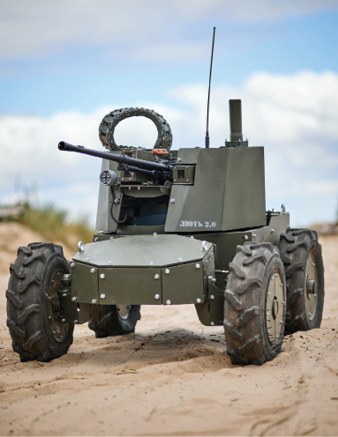
HOW DRONES ARE DICTATING CHANGES TO FORTIFICATIONS AND DEFENSES
Counter-UAS defense is now a fundamental, not ancillary, principle for future operations. Expendability facilitates “numbers game” tactics to wear down defenses that reliably defeat the first few attacks. sUAS can approach from virtually any angle, meaning relying on forward-facing defenses is no longer satisfactory.
Even static fortifications should reflect CUAS principles, such as L-shaped entrances to prevent kamikaze drones from easily gliding inside and supporting protection and firing across 360-degrees. Likewise, tanks require drone-proofing from all aspects—top, side and rear armor—not just the front. Formerly, flanking was difficult and top attack weapons like Javelin were expensive and rare. With drones, top- and side-attack capability is ubiquitous and cheap.
Even Russia’s ill-prepared forces anticipated the problem by installing anti-drone “cope-cages” prior to the full-scale invasion in February 2022. Now cope cages have become virtually compulsory, and vehicle-mounted CUAS jammers have become standard as well. Russia even developed crude turtle tanks with a pancake dome over the tank constraining turret traverse—a testament to the overwhelming magnitude of the loitering munition threat.
Ironically, there is ample footage showing that even such defenses are not perfect as drone operators manage to glide under the protective covering of turtle tanks and cope cages. Still, such defenses at least reduce kill probability of individual attacks. Designers of next-generation kamikaze drones will seek to train AI to analyze which defenses are present on a target and optimize their approach vector accordingly—something only human operators currently can do.
Self-defense jammers and bolt-on cages will likely be offered standard; active protection systems (APS) designed to shoot down anti-tank missiles/rockets will also support counter-drone capability. Russia is already touting upgrades to its Arena-M APS in a counter-drone role, allowing it to consider aerial threats slower than 150 mph—though what the new minimum speed is is an interesting question, as copter drones can also hover slowly toward tanks.
WHY RUSSIA’S VAUNTED SHORT-RANGE AIR DEFENSES FAIL AT C-UAS
Russia’s legacy Soviet short-range air defense (SHORAD) systems were generally well-respected prior to 2022, particularly post-Cold War as western armies rapidly divested SHORAD capabilities like Gepard and Linebacker. But 2015-2020 wars in Libya, Syria and Armenia-Azerbaijan gave early indications that Russia’s newer Tor-M2 and Pantsir systems might have issues countering smaller drones. A lengthy report available online by St. Petersburg professor Sergey Makarenko spells out multiple reasons, based on Russian kinetic CUAS tests in 2020.
The radar on the Tor short-range missile system only detects sUAS at roughly 1.8-2.5-mile ranges, he said, and frequently fails when shooting sUAS due to problems with the warhead detonation control system and imprecise tracking. The missiles on the tracked Tunguska and Pantsir gun/missile truck are actually worse—finding it “practically impossible” to detect sUAS before they entered minimum engagement range.
The very-short-range (VSHORAD) heat-seeking Strela missile, meanwhile, struggles to acquire electrically powered drones, and only locks when facing the rear-aspect of gas-powered ones.
But what about the fearsome autocannons on Tunguska and Pantsir? “Fundamentally possible,” he concedes, “but probability of defeat [of drones] is low.” He notes where a battery of four Tunguskas needed to expend up to 13,000 shells to achieve a 50% kill probability against an Akila target drone 2 miles away. An individual Tunguska carries 1,900 shells.
Makarenko advocates sensor fusion incorporating optical and acoustic sensors, jamming and the use of proximity warheads. These would produce more, smaller fragments rather than the current norm of fewer, larger fragments to damage large airplanes, and in the longer term, the use of lasers and microwave weapons.
RAM X ON AIR DEFENSE-SLAYING HOT STREAK
No single Ukrainian loitering munition in 2023 combined the scale of production and operational depth strike capabilities of Russia’s Lancet loitering munition. Kyiv explicitly sought a Ukrolancet with 43 mile-range, max speed of 111 mph and automatic terminal guidance. By February 2024 two were in production, likely including RAM X by CDET, builder of Leleka 100 ISR drones and the related RAM-II loitering munition. By April, a compilation of videos showed SBU operatives employing RAM Xs to destroy three vehicles from a Buk medium-range air defense battery, five self-propelled anti-aircraft systems (Tor, Strela-10 and Tunguska) and a Borisoglebsk-2 EW system.
THE LITERAL SHOTGUN APPROACH TO CUAS
Small drones are fragile but hard to hit. For that reason, Russian and Ukrainian infantry have found the sprays of buckshot from a shotgun are more reliable than assault rifles as last-ditch defense against incoming kamikaze drones. Many units have dedicated shotgun-armed CUAS specialists on constant lookout for incoming drones, often handpicked for their hunting background or marksmanship. Russian Vepr-12 Molot and Turkish BTS12 are popular, the latter said to be effective out to 120 meters.
UGVS IN UKRAINE: A FORCE-PROTECTOR ROLE
“Lethality” and “force protection” are terms conveying offensive and defensive qualities. Of course, unmanned systems provide intrinsic force protection by keeping operators relatively out of harm’s way compared to manned alternatives—but that’s a narrow way to evaluate their broader impact. Ukraine’s USV and UAV operations are drivers of lethality, increasing attrition dealt to the enemy greatly beyond what their available forces could achieve without them. By contrast, even the armed UGVs combat tested so far aren’t yet poised to contribute much greater lethality than the personnel and vehicles they substitute for.
However, UGVs are serving a force-protection role with the objective of getting dangerous jobs done while exposing fewer humans across the entire force to harm, not just the operators. Undoubtedly, Ukraine’s major efforts in UGV production begun in 2024 will likely have less outwardly dramatic results than the destructive feats of UAVs. But while UGVs may generate fewer videos of exploding tanks, if successful, they may result in more own-side soldiers retaining life and limb thanks to a robot destroyed while clearing a minefield, delivering supplies or overwatching a perimeter.


